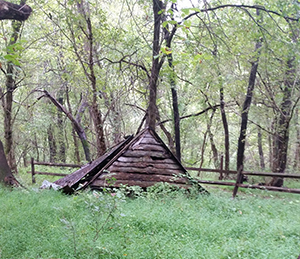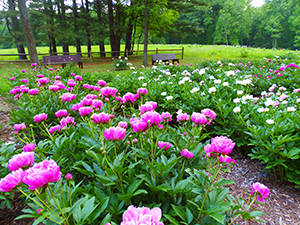Historic Sites
The Seneca Creek valley provides numerous opportunities to explore Montgomery County history.
 Woodlands Estate
Woodlands Estate
Located at the Park Office and Historic Area at 11950 Clopper Road, a self-guided interpretive path reveals the history of the Clopper Family and their estate home “Woodlands.” Francis Cassatt Clopper (a distant relative of the painter Mary Cassatt) was a prosperous merchant who moved to Montgomery County in 1812 and established a huge plantation farm off Clopper Road. Explore the archeological remains of the now-vanished plantation house and its outbuildings, and learn about daily life on a farm across four generations, from before the Civil War up to the middle 1950s.
Grusendorf Log House
 Also located near the Park Office is Grusendorf Log House, the oldest surviving building from the original Germantown, Maryland. Built by a German-American carpenter named Jakob Snyder in 1855, this one-room log cabin once stood near what is now the corner of Clopper Road and Great Seneca Highway. When the land on which the cabin stood was redeveloped in the 1980s, the historic home was relocated to Seneca Creek State Park. Park volunteers present interpretive programs and offer interior tours periodically on weekends from spring through fall. Check the monthly program calendar for open house dates and times.
Also located near the Park Office is Grusendorf Log House, the oldest surviving building from the original Germantown, Maryland. Built by a German-American carpenter named Jakob Snyder in 1855, this one-room log cabin once stood near what is now the corner of Clopper Road and Great Seneca Highway. When the land on which the cabin stood was redeveloped in the 1980s, the historic home was relocated to Seneca Creek State Park. Park volunteers present interpretive programs and offer interior tours periodically on weekends from spring through fall. Check the monthly program calendar for open house dates and times.
Schwartz Peony Garden
 The Schwartz Peony Garden is a living reminder of one of the great commercial horticulture operations in Montgomery County. Now located in Seneca Creek State Park’s Day Use area, the garden was originally planted at Summit Avenue in downtown Gaithersburg.
The Schwartz Peony Garden is a living reminder of one of the great commercial horticulture operations in Montgomery County. Now located in Seneca Creek State Park’s Day Use area, the garden was originally planted at Summit Avenue in downtown Gaithersburg.
Between 1915 and 1924 a prosperous real estate broker and flower fancier, Mr. Edwin P. Schwartz, collected heirloom peonies from dealers in Holland, France, England and Germany as well as the United States. Mr Schwartz’s mansion home, which once overlooked the garden, is now Gaithersburg City Hall. By the 1920s the family had become prominent peony root stock dealers, publishing a catalog offering hundreds of different varieties for order by mail. In the 1940s the family moved their commercial garden operations to five acres in what is now Seneca Creek State Park.
Thousands of individual peony plants in scores of varieties still bloom in the park every May and June. Visit the display garden and walk the open fields to enjoy the spectacular flowers in all their colors and varieties.
Black Rock Mill
Black Rock Mill sits along Great Seneca Creek adjacent to Black Rock Road. Inside the walls of the now roofless old building are displays which tell the history of this 1815 grain-grinding mill. Featuring reinstalled gears and machinery, the displays give a cut-away view of the milling operation. Startling high water marks on the inside of the walls show the magnitude of the floods which have ravaged the Great Seneca valley from time to time over the last century.
Seneca Historic District
Closer to the confluence of Great Seneca Creek and the Potomac River are the Seneca Schoolhouse and Seneca Historic District, including the ruins of the Seneca Stone Mill and Quarries. Located at the end of Tschiffely Mill Road, the quarry is renowned for providing the signature red sandstone used to build the Smithsonian Castle. The nearby one-room schoolhouse, located at 16800 River Road, once served children of quarry workers and other members of the local community. Historic Medley District, Inc. now presents interpretive programs at the restored schoolhouse. Also nearby are Riley’s Lockhouse and Seneca Aqueduct of the Chesapeake and Ohio Canal, both preserved by the National Park Service as part of the C&O Canal National Historic Park.
Waring Viaduct
The park’s Seneca Greenway foot trail offers excellent views of the 110-year-old Waring Viaduct, a three-arch stone railroad bridge that soars high above Great Seneca Creek. Built by the Baltimore and Ohio Railroad to replace an older steel bridge on the same site, this majestic bridge still carries trains high above the Greenway and the valley of Great Seneca Creek. Access the viaduct by walking on the Seneca Greenway north from the Park Office at 11950 Clopper Road (1 mile) or south from the MD Route 355 trailhead parking lot (2 miles). Please note: Waring Viaduct itself is private property and is in active railroad use--never walk or trespass on railroad tracks.